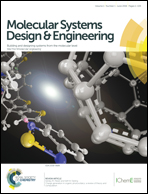Designing multi-layer graphene-based assemblies for enhanced toughness in nacre-inspired nanocomposites
Abstract
Polymers reinforced with multi-layer graphene (MLG) phases are promising candidates for new materials with high modulus, strength and toughness. Drawing inspiration from nacre's layered “brick and mortar” structure, here we propose molecular scale design strategies to improve the mechanical performance of MLG–polymer layer-by-layer nanocomposites. We present a coarse-grained molecular dynamics (CG-MD) study of interfacial failure mechanisms of MLG domains embedded in a poly(methyl methacrylate) (PMMA) matrix through pull-out simulations. Our simulations reveal two distinct deformation and failure mechanisms that greatly influence the toughness and energy dissipation of the system: pull-out failure, which occurs along the MLG–PMMA interface, and yielding failure, which occurs within the graphitic phase through the sliding of staggered graphene sheets. For any length of the graphitic assembly, the energy dissipated per layer from MLG yielding is greater than that of MLG pull-out. Theoretical continuum analysis further reveals that there exists a critical number of layers of graphene, beyond which the failure mode changes from yielding to pull-out. Our modeling framework provides effective strategies to design graphene–polymer layered nanocomposites with optimal toughness, and advance the mechanical performance of nanomaterials.


 Please wait while we load your content...
Please wait while we load your content...